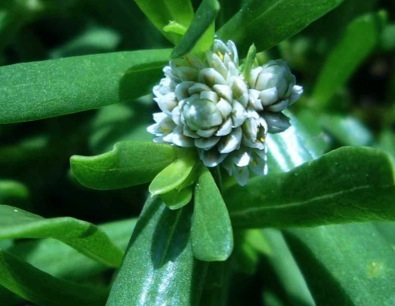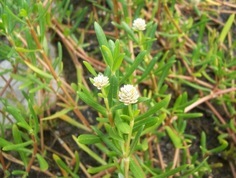Blutaparon vermiculare: Beach Potherb
My first thought on seeing Silverweed “was what is clover doing growing on the beach.” Well, Silverweed isn’t a clover and I soon noticed it didn’t look like clover close up, but the association was made. The next headache was what was it called.
Some writers call it Samphire, but there are several seaside plants called that now. Saltweed is also common, and again several maritime plants are called that now. That leaves Silverweed and Silverhead. There are quite a few Silverweeds as well, so Silverhead it is. Botanically, it has changed names as well. It is currently Blutaparon vermiculare (blew-tap-AIR-on ver-mick-you-LAIR-ee) That means “near Amaranth wormlike.” Bluta is from the Latin word blitum for Amaranth. Paron or para is Greek for near. Vermiculare is Latin for “breeding worms.” In this case it is referring to how the plant grows along the ground. A second opinion says Blutaparon is a corruption of the Latin phrase volutum laparum which means “loose climber” and indeed it is often found climbing on driftwood and other plants nearby.
Like the amaranth, it’s in that family, the B. vermiculare provides leaves and stems are used for the herb pot. Consider it already salted greens. No reports of it being eaten raw by humans. It is commonly fed to chickens in warmer parts of the world. Should you be unable to find in books the plant used to be called Philoxerus vermicularis…. dry loving worm breeder.
Green Deane’s “Itemized” Plant Profile
IDENTIFICATION: Succulent, creeping, prostrate herb with branches one to six feet long. Leaves opposite, spindly or club shaped, from narrow to 3/8 inch wide, one half to 1.5 inches long, thick, fleshy. Flowers silvery white, a dense round or oblong spike. Fruit oval, flat, dark brown, the seed is glossy.
TIME OF YEAR: Generally year round
ENVIRONMENT: Dunes, waste places, inshore from mangrove thickets, keys and mainland.
METHOD OF PREPARATION: Stems and leaves boiled.




found a lot of which I believe is silverweed growing along the intecoastal wateway along the beach in south Florida. It is quite salty when eaten raw, have been able to transplant into to a combination of top soil, soiless potting mix, and beach sand; it is 3 weeks in the pots, has begun to sprout new rosettes of leaves which are turgid, and maintained in semi-shade; I water them with an iodine dilute saline solution 1-2x/d, and, hopefully, will have enough to eat in about 6 weeks. There appears to be plenty to be found, but did not wish to over gather.